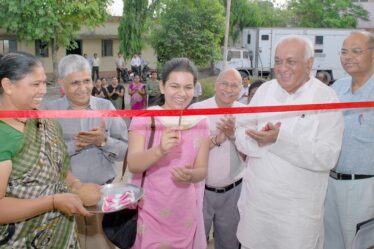In my last post, I told you how deputy prime minister Morarji Desai in 1968 agreed to fund a medical college in rural India. But there was a catch—a formidable one.
The hospital would need to raise 25% of the funds itself. Not just once, but every year. Forever.
The formula was simple on paper: 50% from the union government, 25% from the state, and 25% from the Kasturba Health Society.
That last quarter? It felt like climbing Everest barefoot.
It was a staggering sum. Two crores in 1968.
Dr. Sushila Nayar was a physician, yes—and a seasoned politician—but not an economist. When she agreed to the funding arrangement, she hadn’t fully grasped where the money would come from. Or how much anxiety it would bring.
Then, a ray of hope.
Gandhi Smarak Nidhi sent ₹10 lakhs. Not as a grant, but as a fund whose interest—at 7% per annum—could be used for working capital.
A modest beginning, but suddenly, the idea of India’s first rural medical college no longer seemed like a dream. It loomed—real, enormous—on the horizon.
But not everyone was thrilled. The projected cost: ₹2 crores. Escalation? Inevitable.
And she had just ten lakhs—tied tightly in the corner of her 𝘴𝘢𝘳𝘦𝘦 𝘱𝘢𝘭𝘭𝘶, as countless Indian women have done when trust in banks or briefcases felt misplaced.
When Sushila Nayar returned to Sevagram, sleep eluded her.
Had she made a colossal mistake?
Had she walked into a financial trap?
A college—within a year?
Where would the students stay? What would they eat? Who would teach them? Where were the wards, the patients, the classrooms?
She paced. Worried. Alone. She couldn’t sleep that night.
The next morning, she walked slowly toward the Sevagram Ashram—eyes swollen, her brow furrowed deep. Her face bore the unmistakable stamp of sleepless worry.
𝗔𝗻𝗮𝗻𝘁 𝗥𝗮𝗺𝗷𝗶 saw it at once.
A towering figure with a flowing white beard, long hair, and a voice that often murmured to himself as he strode briskly through the village lanes, Anant Ramji had been part of Sevagram since 1941.
He had worked with Gandhiji and had earned his appreciation for selfless work. He had done everything the Ashram needed—cattle care, agriculture, accounting, selling Gandhi’s books. He was known for his humor and his unpredictable, wise-cracking tongue.
When he heard what troubled Sushila, he laughed.
“Stop worrying,” he said.
“ऊपर वाला देता है, तो छप्पर फाड़ के देता है !”
God doesn’t give in half measures.
Sushila smiled, but inwardly dismissed him. This was typical Anant Ramji. Colorful, kind, but who could take him seriously?
The next day, in Delhi, she was summoned by an official in the Union Health Ministry.
“We’ve been waiting for you,” he said. “Prepare a project report. Submit it to the United States Agency for International Development (USAID). We think they might fund you.”
She hurriedly wrote a grant. The time was slipping past. She asked for ₹2 crores, hoping for ₹1 crore.
They gave her two.
Just like that.
That very same year, St. John’s Medical College, Bengaluru was founded with a grant of ₹5 crores from USAID.
Had Sushila negotiated better, she might have secured a matching amount. But Sushila Nayar wasn’t a dealmaker. She wasn’t after money. She wanted doctors who would serve the poor.
And so, in the Gandhi Centenary Year of 1969, the Mahatma Gandhi Institute of Medical Sciences was born.
An institution forged in faith, not finance.
She never learned the dark arts of funding. But she had one strength: she believed. Fiercely, naively, purely.
Decades later, the echo of that faith returned.
Three of Anant Ramji’s grandchildren would become MGIMS alumni—Satish, a radiologist from 1983 batch; Harish Pathak, a forensic medicine professor from 1986 batch; and Suniti, a pathologist from 1993 batch. His son-in-law, Shri Manilal Pathak, worked for years in the MS and Dean office, always clad in a 𝑘ℎ𝑎𝑑𝑖 𝑘𝑢𝑟𝑡𝑎 𝑎𝑛𝑑 𝑑ℎ𝑜𝑡𝑖, typing quietly on his Remington typewriter.
Some words linger long after the voice that spoke them has fallen silent. Fittingly, Anant Ramji passed away just two months after Dr. Sushila Nayar—in March 2001.
Anant Ramji had spoken such words.
And they came true.
How did Sushila Nayar manage to find faculty for Anatomy, Physiology, Pathology, and Pharmacology for the very first batch of medical students in 1969?
That story—full of surprises—will have to wait for my next post.
